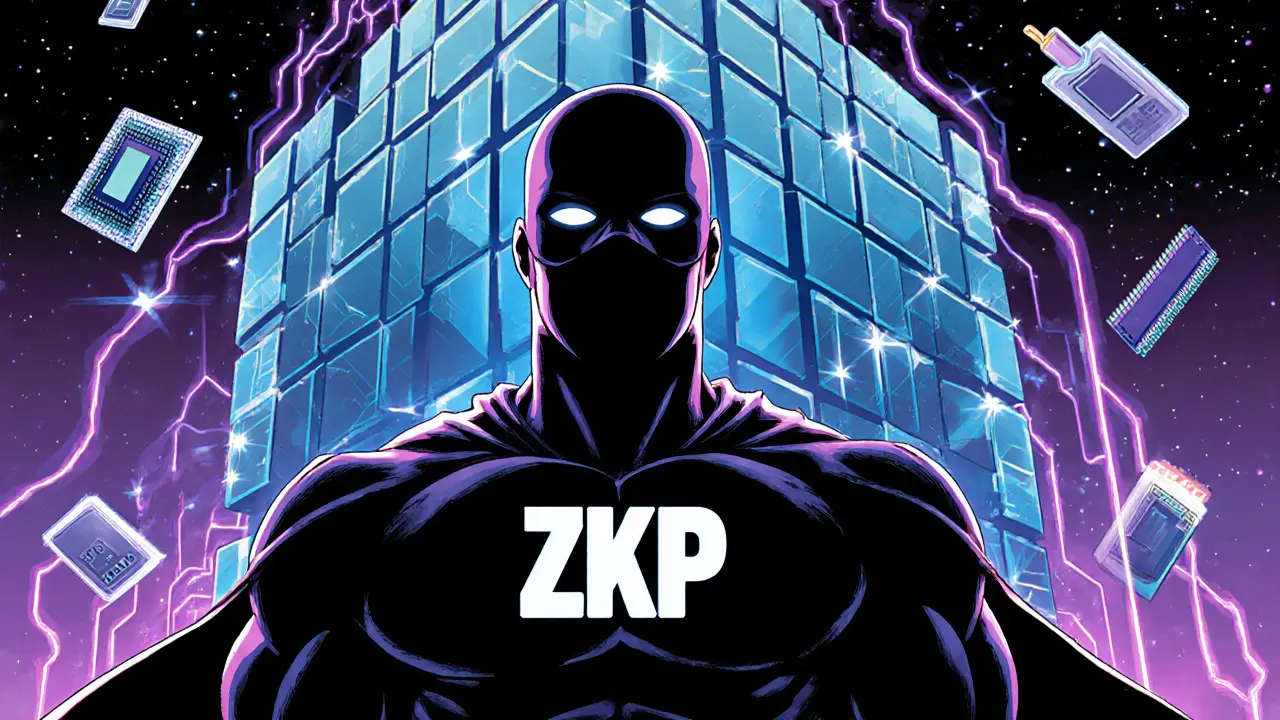Understanding the Computational Cost of Zero-Knowledge Proofs in Blockchain
ZKP Cost Estimator
Cost Estimation Parameters
Estimated Computational Costs
Results will appear here after calculation
When a blockchain tries to keep data private while still proving correctness, it leans on zero-knowledge proofs. The catch? Generating and checking those proofs eats CPU cycles, memory, and sometimes even bandwidth. This article breaks down where the cost comes from, how different proof systems stack up, and what you can do to keep the numbers in check.
Key Takeaways
- Proof generation is usually the biggest expense; verification is often cheap for SNARKs but heavier for STARKs.
- Circuit size and the choice of cryptographic primitives directly drive CPU and memory usage.
- SNARKs, STARKs, Bulletproofs, and zk‑Rollups each trade proof size for prover or verifier time.
- Optimizing circuit design, using recursion, and off‑loading work to specialized hardware can cut costs dramatically.
- Real‑world blockchain deployments report prover times from a few seconds to several minutes, depending on proof type and transaction complexity.
What Do We Mean by “Computational Cost”?
Computational cost refers to the amount of processing time, memory, and sometimes network bandwidth required to create and verify a cryptographic proof. In the ZKP world, we split that cost into two buckets:
- Prover cost - CPU cycles, RAM, and sometimes GPU cycles needed to turn a private statement into a proof.
- Verifier cost - the work the blockchain node does to check that proof without learning the secret.
Both sides matter for a scalable blockchain: a heavy prover slows down users; a heavy verifier burdens every full node.
Core Drivers of Cost in ZKPs
Three technical ingredients dominate the performance picture:
- Circuit size the number of gates or constraints a statement is compiled into. Larger circuits mean more arithmetic operations during proving.
- Cryptographic primitive the underlying math, such as elliptic‑curve pairings for SNARKs or hash‑based commitments for STARKs. Pairing‑based work is CPU‑heavy but yields tiny proofs; hash‑based work is more parallelizable but produces bigger proofs.
- Proof system architecture whether the protocol is interactive, non‑interactive, recursive, or uses a trusted setup. Each design choice shifts the balance between prover and verifier effort.
Cost Profiles of Popular Proof Systems
Below is a snapshot of how four widely used systems compare on the three cost dimensions. Numbers are drawn from public benchmarks (2023‑2024) and illustrate typical ranges for a 256‑bit statement.
| Proof System | Prover Time (seconds) | Verifier Time (ms) | Proof Size (KB) | Trusted Setup? |
|---|---|---|---|---|
| SNARK (e.g., Groth16) | 0.8 - 5 | 0.2 - 1 | 0.1 - 0.3 | Yes |
| STARK | 2 - 12 | 5 - 30 | 10 - 30 | No |
| Bulletproofs | 1 - 8 | 0.5 - 2 | 1 - 5 | No |
| zk‑Rollup (Ethereum) | 3 - 15 (batch of 100 tx) | 1 - 4 (per batch) | 5 - 12 (batch proof) | Varies |
Key observations:
- SNARKs win on verifier speed and proof size but need a trusted setup.
- STARKs avoid trust assumptions but ask the verifier to compute more hashes.
- Bulletproofs sit in the middle, offering no setup and moderate proof sizes, but they scale linearly with statement size.
- zk‑Rollups bundle many transactions, turning many small prover costs into a single larger batch proof.
Blockchain Case Studies
Real‑world networks give us concrete numbers that help gauge feasibility.
- Zcash uses a SNARK (Groth16) for shielded transactions. A typical transaction costs about 1‑2 seconds of CPU on a modern laptop and creates a 200‑byte proof.
- Ethereum zk‑Rollup (e.g., zkSync) employs PLONK‑style SNARKs for batch verification. Proving a batch of 100 transfers takes roughly 8‑10 seconds, while each validator verifies the batch in under 5 ms.
- StarkNet relies on STARK proofs for smart‑contract execution. A single contract call may need 5‑12 seconds of prover time and verification around 20‑30 ms on a typical node.
Notice how the prover cost can still be a bottleneck for user‑facing wallets, prompting several projects to offer “relayer” services that offload the heavy work.

Techniques to Tame the Cost
If you’re designing a new protocol or integrating ZKPs into an existing chain, consider these proven tricks.
- Circuit optimization. Reduce gate count by flattening boolean logic, reusing sub‑circuits, and exploiting domain‑specific shortcuts (e.g., range checks via lookup tables).
- Recursive composition. Generate a proof of a proof. This lets you compress many small batches into a single outer proof, dramatically lowering on‑chain verification work.
- Hardware acceleration. GPUs excel at field arithmetic; ASICs are emerging for pairing operations. Off‑chain farms can produce SNARKs at 10× the speed of a CPU.
- Hybrid schemes. Pair a cheap SNARK for frequent, low‑value ops with a STARK for high‑value, audit‑level proofs. The mix keeps overall cost bounded.
- Parameter tuning. Choose field sizes and commitment depths that match your security level without over‑provisioning.
Developer Checklist for Cost‑Aware ZKP Integration
- Map each on‑chain operation to a circuit and estimate gate count.
- Pick a proof system that aligns with your trust model (trusted setup vs transparent).
- Run a benchmark on your target hardware; record both prover CPU seconds and verifier milliseconds.
- Plan for proof‑generation services if prover time exceeds a few seconds for end users.
- Document proof size limits for your transaction pool to avoid bloating blocks.
Frequently Asked Questions
Why are SNARK provers faster than STARK provers?
SNARKs rely on elliptic‑curve pairings, which, despite being mathematically heavy, can be computed with a handful of field multiplications. STARKs replace pairings with large Merkle‑tree hashes that need many more rounds of compression, inflating CPU time.
Can I avoid a trusted setup entirely?
Yes. Transparent proof systems such as PLONK (post‑trusted-setup variants), STARKs, and Bulletproofs do not require a secret ceremony. They trade a bit more prover work or larger proofs for the trust benefit.
How does proof size affect blockchain bandwidth?
Every extra kilobyte must travel through every node and be stored forever. On a high‑throughput chain, a 30 KB STARK proof can cut the number of transactions per second in half, whereas a 0.2 KB SNARK proof barely registers.
Is GPU acceleration worth the investment?
For pairing‑based SNARKs, GPUs can deliver 5‑10× speedups on prover operations. The ROI improves when you batch many proofs or run a relayer service for end users.
What’s the biggest open research challenge today?
Bridging the gap between low‑cost provers and ultra‑small, verifier‑free proofs without a trusted setup. Researchers are chasing recursive STARKs that keep verification under a millisecond while staying transparent.
Understanding the computational cost of zero‑knowledge proofs lets you pick the right tool for your blockchain use case, balance user experience against security, and plan the infrastructure you’ll need to keep the network humming.






19 Comments
Tom Grimes
October 22 2025Reading about zero‑knowledge proof costs feels like being stuck in a dark room with a flickering light. The way the article drags on about circuit size makes me wonder if the writer even knows what a gate is. I keep hearing about SNARKs and STARKs but the explanations just bounce around like a tired echo. It seems the author wants us to feel overwhelmed on purpose. Every paragraph adds a new layer of jargon without giving a real example. The CPU cycles mentioned feel like a personal attack on my hardware. I am left imagining my laptop melting under the prover load. My mind wanders to the endless memory usage graphs that never end. The bandwidth concerns sound like a distant threat to my internet plan. I suspect the writer enjoys watching us squirm over numbers. The tone of the article is quietly aggressive, as if it wants us to accept the cost as inevitable. It whispers that we must sacrifice performance for privacy, and I cannot swallow that. I am not convinced that the trade‑offs are worth the hype. The long‑winded style drains the energy out of any reader. Perhaps a simpler breakdown would have spared everyone the headache. In the end, the piece feels more like a lament than a guide.
Paul Barnes
October 22 2025Most people glorify SNARKs as the silver bullet, but the hidden costs are rarely acknowledged. The article glosses over the trusted setup controversy, pretending it's a minor footnote. In reality, that ceremony opens a backdoor that no one wants to admit.
John Lee
October 22 2025Zero‑knowledge proofs are like magical curtains that let you hide the stage while still showing the show. When the prover spins the cryptographic wheel, you can almost hear the gears of computation humming. The circuit size is the blueprint of that wheel, and every extra gate adds a splash of color to the picture. SNARKs might sprint with tiny proofs, but they need that secret handshake before the race even starts. STARKs run slower, yet they proudly wave a transparent flag for the world to see. By blending the right system with clever recursion, developers can paint a masterpiece without burning all their CPU ink.
Rebecca Kurz
October 22 2025Proof size directly impacts network bandwidth!!! Smaller proofs keep the chain nimble!!!
Ryan Steck
October 22 2025Yo these SNARKs are a total scam, they say it's fast but you gotta trust some secret setup. I ain't buying it, just another way to control the game.
Patrick Day
October 22 2025They hide the truth about the setup in fine print, so the average user never knows who's pulling the strings.
Jenna Em
October 22 2025The balance between prover effort and verifier ease is a tightrope walk over a canyon of uncertainty. If you push too hard on the prover side, users will abandon the system out of frustration. On the other hand, a heavy verifier slows every node, threatening decentralization. My take is to aim for a middle ground where both sides keep breathing. Transparent proof systems like PLONK give us that sweet spot without a hidden ceremony. In the end, it's all about choosing the right tool for the job, not chasing hype.
Evan Holmes
October 22 2025Proofs are just data.
Erik Shear
October 22 2025Yep small size matters
BRIAN NDUNG'U
October 22 2025The article provides a comprehensive overview of computational demands inherent to zero‑knowledge protocols. It systematically enumerates the factors influencing prover and verifier workloads, such as circuit depth and cryptographic primitives. By presenting benchmark data alongside practical recommendations, the author equips developers with actionable insights. Nonetheless, a deeper examination of hardware acceleration would further enhance the utility of the guide. Overall, the exposition maintains a high standard of technical rigor.
Donnie Bolena
October 22 2025Great job breaking down the costs!!! This will help many teams plan their scaling strategies!!! Looking forward to seeing more hardware‑accelerated solutions!!!
Elizabeth Chatwood
October 22 2025i think using recursion is a good move it can cut a lot of work off the chain but we need more tooling to make it easy
mike ballard
October 22 2025The integration pipeline should consider field element packing to reduce gate count, especially when dealing with elliptic‑curve pairings 😊. Leveraging SIMD instructions on modern CPUs can also shave milliseconds off prover time.
Tom Glynn
October 22 2025Contemplating ZKP efficiency feels like pondering the nature of reality itself 🌌. Each optimization reveals another layer of hidden complexity, reminding us that progress is a continuous journey. Keep experimenting, and the community will benefit from shared breakthroughs. 🚀
Johanna Hegewald
October 22 2025Make sure to benchmark both prover and verifier on the target hardware before finalizing the proof system.
Ty Hoffer Houston
October 22 2025Balancing privacy and performance is a shared challenge across many blockchain projects. Open collaboration and sharing of benchmark results can accelerate progress for everyone. Let's keep the conversation constructive and inclusive.
James Williams, III
October 22 2025Indeed, the trade‑off matrix between proof size and verification latency is central to protocol design, and community datasets are invaluable.
Isabelle Filion
October 22 2025The pretentious exposition of zk‑rollup economics betrays a condescending attitude towards practical engineers. One would hope for a more grounded analysis rather than lofty platitudes.
PRIYA KUMARI
October 22 2025Stop sugar‑coating the limitations; the reality is that many users cannot afford the prover burden.